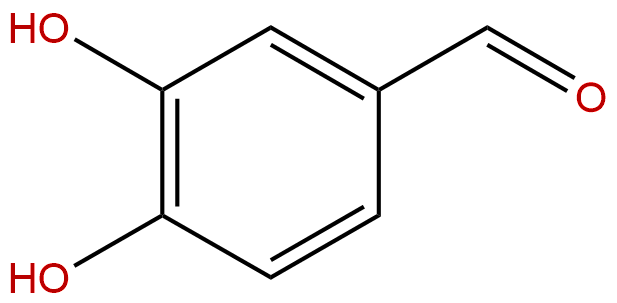Protocatechualdehyde Descrtption
Product name: Protocatechualdehyde
Synonym name: Catalogue No.: BP1154
Cas No.: 139-85-5
Formula: C
7H
6O
3Mol Weight: 138.122
Botanical Source: heartwood of Cassia garrettiana
Physical Description: Powder
Type of Compound: Phenols
Purity: 95%~99%
Analysis Method: HPLC-DAD or/and HPLC-ELSD
Identification Method: Mass, NMR
Packing: Brown vial or HDPE plastic bottle
Storage: Store in a well closed container, protected from air and light. Put into refrigerate or freeze for long term storage.
Whenever possible, you should prepare and use solutions on the same day. However, if you need to make up stock solutions in advance, we recommend that you store the solution as aliquots in tightly sealed vials at -20℃. Generally, these will be useable for up to two weeks.
The product could be supplied from milligrams to grams, up to kilograms
Inquire for bulk scale.
Descriptions:3,4-Dihydroxybenzaldehyde, isolated from the outer skin of green ,has been shown to inhibit the growth of Gloeosporium musarum, a fungus which causes ripe fruit rot in the banana.[1]
3,4-Dihydroxybenzaldehyde can inhibit oxidative DNA damage and apoptosis via its antioxidant activity.[2]
3,4-Dihydroxybenzaldehyde inhibits the phosphotransferase activity of CKII with IC(50) of about 783 microM, it may function by inhibiting oncogenic disease, at least in part, through the inhibition of CKII activity.3]
3,4-Dihydroxybenzaldehyde inhibits the H2O2-induced apoptosis of granulosa cells, promotes estradiol secretion in granulosa cells and enhanced the mRNA expression levels of steroidogenic factor 1, a promoter of key steroidogenic enzymes. [4]
3,4-Dihydroxybenzaldehyde has tyronase inhibitory effect.[5]
References:[1] Mulvena D, Webb E C, Zerner B. Phytochemistry, 1969, 8(2):393-5.
[2] Jeong J, Hong S H. Phytomed Intl J Phytother Phytopharm, 2009, 16(1):85-94.
[3] Lee B H, Yoon S H, Kim Y S, et al. Nat Prod Res, 2008, 22(22):1441-50.
[4] Kono R, Nomura S, Okuno Y, et al. Acta Histochem Cytoc, 2014, 47(3):103-12.
[5] Shin Dong-Soo, Paik, Do-Hyeon, Yoon Do-Young, et al. The Korea Jounnal of Herbology, 2006, 21(2):1-7.
[6] Xia C Y, Chen L M, Hu W X. Synthetic chemistry, 2004, 12 (5): 484-6.


